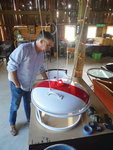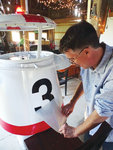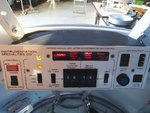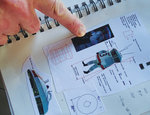




If you are walking around in greater Lansing this summer and a man in a white tub beckons to you, waving rubbery arms and emitting bursts of static, don’t run away. It’s only Dave Busch, trying in his own way to communicate to you.
His message: this summer marks the 50th anniversary of the first manned lunar expedition. Acknowledge.
Area space fanatics will surely mark this summer’s milestone in many ways, but Busch, 53, is a local singularity.
Last Thursday, he was nearing the end of four months of nights and weekends recreating a 1962 prototype of a lunar explorer’s suit in his workshop-barn east of Lansing. He lives in Perry and commutes daily to work in Old Town.
The MK-1 Integrated Moon Suit, or “man in a can,” made the cover of Life magazine and became a toy that’s now worth hundreds of dollars on eBay, but was never used by NASA.
This summer, Busch plans to don the suit and materialize wherever he gets the urge, at Lansing area festivals or just to liven up slow legislative days near the Capitol.
Well, maybe not too close. “I’m a little nervous about the security there,” he said.
A portrait of the suit’s designer, buzz-cutted engineer Allyn “Hap” Hazard, is reverently nailed to a pole in the barn that doubles as Busch’s workshop.
“If nobody else has built this suit, then only two people have — him and me,” Busch said. “And I don’t know of anyone else.”
Lunar convoy
Last week, Busch was hunkered down in the barn, fitting plastic sheets into the helmet visor as the moon suit hung silently on suspended dowels. A plastic chandelier hung overhead and a Mozart quintet played in the background. After months of work, the project was down to the visor and several other details, including the iconic number “3.”
Busch built model airplanes as a kid, but never anything like this. He remembers watching the Apollo 11 moon landing on TV 50 years ago.
“I was only 3, but I knew something important was happening,” he said.
He first saw the MK-1 moon suit in a book, “Man in Space,” from a set of Time-Life science books his parents collected. The suit also did a spectacular star turn on the cover of Life Magazine April 27, 1962, to accompany a speculative story on lunar exploration.
Hazard, an engineer at Space-General Corp. in the 1950s and ‘60s, looked beyond the proposed Apollo moon landings nearly 10 years before they became reality.
He imagined that man’s first small steps on the moon would be followed by real work: a 12-man convoy of cargo and passenger-carrying rockets, with civilian scientists in tow.
In Hazard’s vision, four explorers would live, eat, sleep and work in the suits as they did their work, with eight support personnel staying near the convoy ships.
While working on the suit, Busch has collected any snippets of information about it he could find, which isn’t much.
Hazard’s rocket convoy is shown parked near a picturesque lunar crevasse in a futurist period magazine published by the owner of Space-General Corp., Aerojet, in 1961. Moon-suited researchers wander the area, decked out in radiation–resistant “umbrellas.”
Busch left the cosmic parasols out, banking that he can get away without a radiation shield in Lansing.
The “man in a can” design looks silly now, but Hazard envisioned long journeys in the suits of up to 500 miles, followed by assist vehicles. The suits would enable the moonwalkers to slip their hands out of the sleeves, eat, sleep, scratch their noses or do whatever else they needed to do. Fully loaded, the suit weighed 350 pounds — only about 50 pounds in the Moon’s weak gravitational field.
Needless to say, NASA never used the design. By the time humans walked on the moon for the first time on July 20, 1969, it was only for two hours, in a much more maneuverable (but still bulky) spacesuit. The big lunar research convoys Hazard envisioned never came to pass.
The barrel suit became a curiosity, albeit a persistent one.
Professor John Lyman of UCLA and several of his experimental engineering students put the suit through a few amusing paces as part of a research project. A tongue-in-cheek spread in the August 6, 1961, issue of the Syracuse Post-Standard showed one student inside the suit, chasing a frightened co-ed. In another photo, he’s upended like a turtle, with his friends helping him get back up.
Major Matt Mason, a Mattel toy based on Hazard in his space suit, goes for hundreds of dollars on eBay.
Around 2000, Busch saw a piece of junk mail lying on his desk at work. A marketer’s steampunk-ish logo featured a familiar image: the man in the can.
“That triggered me,” he said. The image was still seared in his mind from the Time-Life book he pored over as a kid.
“I needed to build this.”
How he built it
Busch compared his obsession over the suit to the UFO mania of Richard Dreyfuss in “Close Encounters of the Third Kind.”
In the film, Dreyfuss even sculpts his mashed potatoes into a mini-Devil’s Tower, where aliens planned to rendezvous with Earthlings.
One morning before work, Busch went to the Golden Harvest Restaurant in Old Town with a stack of reference photos. He didn’t order mashed potatoes, but he did bring a notebook and worked out a set of dimensions, using Hazard’s head as a reference point, over coffee. (Most heads are about 6 inches wide.)
Busch’s hands look pretty banged up. The bottom half of his left thumbnail is dark purple, owing to a blow from a slipped wrench.
“Oddly enough, construction has gone remarkably well,” he said.
The main body “can” is a 4-foot-by-8-foot sheet of heavy duty PVC plastic he bought at a sign shop on Lansing’s west side.
“They don’t usually sell plastic to people,” he said. “When I told them I’m building a space suit, they looked terrified, but they took my money.”
The sheet was relatively cheap at 50 bucks, but he didn’t want to go through more than one. The first cut had to be just the right size.
To his surprise, he found that “some online fanatic” created a template maker for various geometric solids, including the shape of the moon suit’s main shell — a truncated cone.
He plugged in the dimensions, took the resulting drawing to Kinko’s and blew it up to full scale. The resulting sheet of plastic was almost the perfect size.
He found a credible instrument panel at MSU Surplus that turns the view from inside the suit into straight-up science fiction. A real air pressure gauge is screwed into the hull nearby.
“It’s stuck at zero, though,” Busch said. “If we were on the Moon, we’d be in trouble.”
The arms are made of heavy-duty, rubber coated flexible hose —stronger and more expensive than dryer vent hose, but worth it.
A small dryer vent serves as a vent near the wearer’s behind. Bright trailer lights illuminate the undercarriage.
Busch stole straps from his son’s book bag to go over his shoulders. A pair of black Kinco work gloves and old-fashioned rubber galoshes complete the ensemble.
The helmet is the literal, and figurative, topper. Aluminum bicycle wheel rims served as ideal rigid, lightweight frames to craft a spectacular headpiece. The slick, circular helmet is capped by a Radio Flyer sled, painted white. Magnetic antennas, for use on trucks, bristle on top, for a Sputnik-era flourish.
The suit has a few bells and whistles Hazard never thought of, such as a microphone and external speaker.
“I have a way to communicate with any people that I encounter,” Busch announced, getting into character early.
The speaker will also emit a carefully crafted mix of ambient music and sound effects, via a Bluetooth amplified speaker.
Busch hooked the sound system up as he fiddled with the suit last Thursday.
The barn hummed with a weird haze of NASA sound effects and chatter mixed with Trent Reznor’s ominous, groaning-metal score for the video game “Quake” and the floaty music of Floex (Czech composer Tomá Dvorák) from the game Samorost.
He worked at fitting a tubular PVC bumper around the base of the helmet.
“I don’t know what that was for,” Busch said. “Maybe some kind of umbilical.” For his purposes, the bumper adds approximately 4 percent more space weirdness.
As Busch battled the tubes, which kept popping out of place, the setting sun peeked through the slats of the barn, throwing tiny pools of light everywhere.
One of them rested on Allyn Hazard’s face.
“Look at that!” Busch said.
He took it as an omen. It was time to apply the number “3.”
Busch soaked the 18-inch “3” decal in water for a few minutes and applied it with the gentlest caress to the suit’s ventral surface.
“I’ve been waiting to do this since forever,” he said.
Busch is sure that his dad, an engineer who died in 2006, would have gotten a bang out of the project.
“He was the gentlest, most intelligent engineer and mathematician,” he said. “Anything I know about repairing anything, I learned from him.”
The number “3” was crooked by just a hair.
“It’s going to bother me. It’s going to bother me,” he intoned.
He somehow salvaged both layers of the decal without cracking it, moved it a few millimeters and pressed down again.
As he peeled the top layer away, the suit suddenly looked like the real thing.
“Hee-hee-hee-hee!” he cackled.
He pressed out the wrinkles with a yellow spatula adorned with a smiley face.
“Looks good,” he said quietly.
He’s not afraid of dings and dirt. On the contrary, the suit is likely to look even more realistic after a few expeditions to the mean streets of Lansing.
“Look at the Apollo suits,” he said. “Those things came back covered in dust.”
The last thing to go in will be the beer can holder.
Support City Pulse - Donate Today!
Other items that may interest you

Comments
No comments on this item Please log in to comment by clicking here